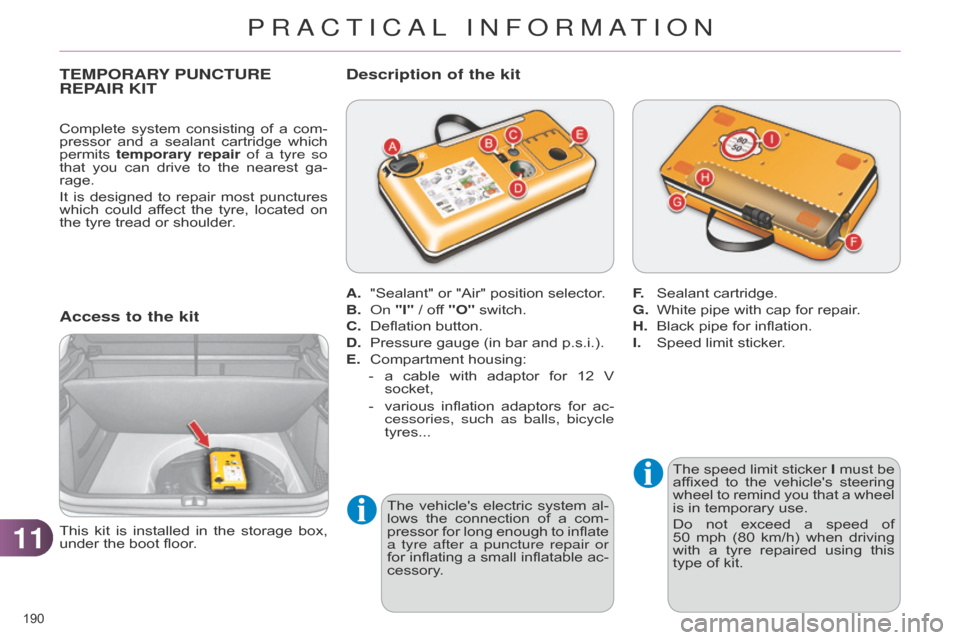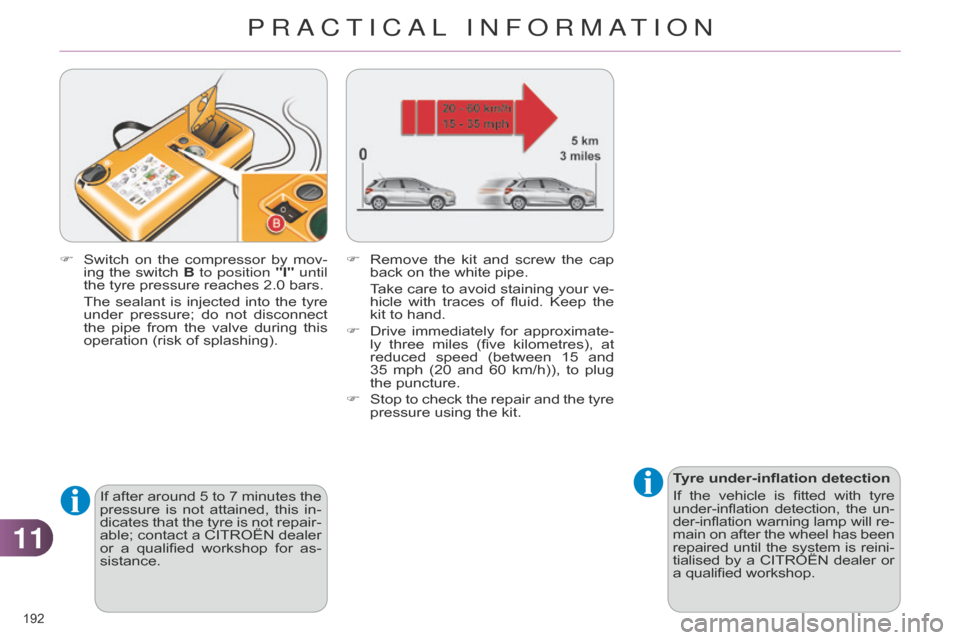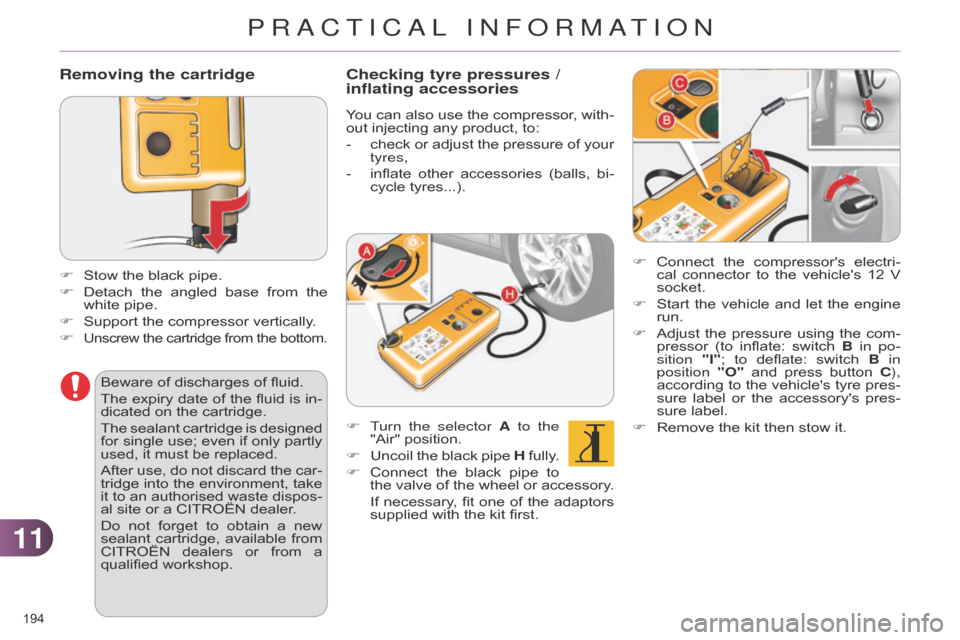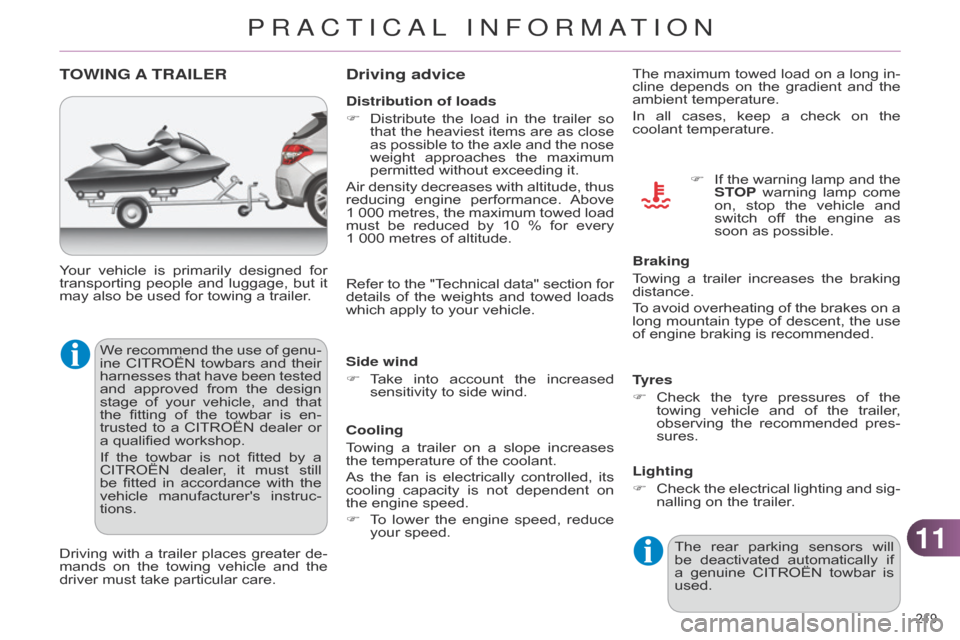tyre pressure Citroen C4 DAG 2014.5 2.G Owner's Manual
[x] Cancel search | Manufacturer: CITROEN, Model Year: 2014.5, Model line: C4 DAG, Model: Citroen C4 DAG 2014.5 2.GPages: 340, PDF Size: 12.89 MB
Page 13 of 340

11
ECO-DRIVING
Limit the causes of excess consumption
Spread loads throughout the vehicle; place the heaviest items
in the bottom of the boot, as close as possible to the
rear
seats.
Limit
the
loads
carried
in
the
vehicle
and
reduce
wind
resis
-
tance
(roof
bars,
roof
rack,
bicycle
carrier
,
trailer
...).
Use
a
roof
box in preference.
Remove
roof bars and roof racks after use.
At
the
end
of
winter
,
remove
snow
tyres
and
refit
your
sum
-
mer
tyres.
Observe the recommendations on maintenance
Check the tyre pressures regularly , when cold, referring to the
label in the door aperture, driver's side.
Carry
out this check in particular:
-
before
a long journey,
-
at
each change of season,
-
after
a long period out of use.
Don't
forget
the
spare
wheel
and
the
tyres
on
any
trailer
or
caravan.
Have
your
vehicle
serviced
regularly
(engine
oil,
oil
filter
,
air
filter
,
passenger
compartment
filter
...)
and
observe
the schedule
of
operations
recommended
in
the
manufacturer's service
schedule.
With
a
BlueHDi
Diesel
engine,
if
the
SCR
system
is
faulty
your
vehicle
becomes
polluting;
go
to
a
CITROËN
dealer
or
a
qualified
workshop
without
delay
to
have
the
emissions
of
nitrous
oxides brought back to the legal level.
When
refuellin
g,
do
not
continue
after
the
third
cut-of
f
of
the
nozzle
to avoid any overflow.
At
the
wheel
of
your
new
vehicle,
it
is
only
after
the
first
1
800
miles
(3
000
kilometres)
that
you
will
see
the
fuel
consumption
settle down to a consistent average.
Page 23 of 340

21
C4-2_en_Chap01_controle-de-marche_ed01-2014
Warning/indicator lampis onCause Action/Observations
Foot on the clutch** fixed.In
the STOP
mode of Stop &
Start,
changing to START
mode
is refused because the
clutch
pedal is not fully down.You
must declutch fully to allow the
change
to engine START
mode.
**
Only on the two-tone instrument panel without audio system.
Dynamic
stability control (DSC/ASR) flashing.
Regulation by the system is
active.
The
system optimises traction and
improves
the directional stability of the
vehicle.
fixed, associated with
illumination of
the
indicator lamp
in
the deactivation
button,
accompanied
by
an audible signal
and
a message.
The DSC/ASR or hill start assist system has a fault.Have
it checked by a CITROËN dealer or a
qualified workshop.
Power
steering fixed.The
power steering has a
fault. Drive
carefully at reduced speed.
Have
it checked by a CITROËN dealer or
a
qualified workshop.
Under-inflation fixed.
The
pressure in one or more
wheels
is too low. Check
the pressure of the tyres as soon
as
possible.
This
check should preferably be carried
out
when the tyres are cold.
+ flashing
then
fixed,
accompanied
by the Service warning
lamp. The
tyre pressure monitoring
system
has a fault or no
sensor
is detected on one of
the
wheels. Under-inflation
detection is not assured.
Have
the
system
checked
by
a
CITROËN
dealer
or a qualified workshop.
Directional
headlamps flashing.The
directional headlamps
system
has a fault. Have
it checked by a CITROËN dealer or
a
qualified workshop.
1
MONITORING
Page 125 of 340

88
123
C4-2_en_Chap08_securite_ed01-2014
BRAKING ASSISTANCE SYSTEMS
Group of supplementary systems which help
you to obtain optimum braking in complete
safety in emergency situations:
-
anti-lock
braking system (ABS),
-
electronic
brake
force
distribution
(E
b F d ),
-
emergency
braking assistance (EBA).
When
braking
in
an
emergency
,
press
very
firmly
without
releas
-
ing
the pressure. When
replacing
wheels
(tyres
and
rims),
ensure
that
they
con
-
form
to
the
manufacturer's
rec
-
ommendations. When
braking
in
an
emergency
,
press
firmly
without
releasing
the
pressure.
Anti-lock braking system
and electronic brake force
distribution
Linked systems which improve the sta -
bility and manoeuvrability of your vehicle when
braking,
in
particular
on
poor
or slippery
surfaces.
Activation
The
anti-lock
braking
system
comes
into
operation
automatically
when
there
is
a risk of wheel lock.
Normal
operation
of
the
ABS
may
make
itself
felt
by
slight
vibration
of
the
brake
pedal. Operating fault
If
this
warning
lamp
comes
on,
accompanied
by
an
audible
signal
and
a
message
in
the
screen,
it
indicates
a
malfunc
-
tion
of
the
anti-lock
braking
system
which
could
result
in
loss
of
control
of
the
vehicle when braking.
If
this
warning
lamp
comes
on, together
with
the
ST
OP
and ABS
warning
lamps,
accompa
-
nied
by
an
audible
signal
and a
message
in
the
screen,
it
indicates
a malfunction
of
the
electronic
brake
force distribution
which
could
result
in
loss
of control
of the vehicle when braking.
You must stop as soon as it is safe
to do so.
Emergency braking assistance
System which, in an emergency , en -
ables you to obtain the optimum braking
pressure
more
quickly
,
thus
reducing
the
stopping distance.
Activation
It
is
triggered
by
the
speed
at
which
the
brake
pedal is pressed.
The
ef
fect
of
this
is
a
reduction
in
the
resistance
of
the
pedal
and
an
increase
in
braking efficiency.
In either case, contact a CITR
o
Ë
n
dealer
or
a
qualified
workshop.
SAFETY
Page 154 of 340

99
152
C4-2_en_Chap09_conduite_ed01-2014
TYRE UNDER-INFLATION DETECTION
System which automatically checks the pressures
of the tyres while driving.
The
system
continuously
monitors
the
pressures of the four tyres, as soon as
the
vehicle is moving.
A
pressure
sensor
is
located
in
the
valve
of
each
tyre
(except
the
spare
wheel).
The
system
triggers
an
alert
if
a
drop
in
pressure
is
detected
in
one
or
more
tyres. This
system
does
not
avoid
the
need
to
check
the
tyre
pressures
regularly
(including
the
spare
wheel)
and before a long journey.
Driving
with
under-inflated
tyres
adversely
af
fects
road
holding,
extends
braking
distances
and
causes
premature
tyre
wear
,
particularly
under
arduous
con
-
ditions
(vehicle
loaded,
high
speed,
long journey).
Driving
with
under-inflated
tyres
increases
fuel consumption.The tyre pressures for your vehi-
cle
can
be
found
on
the
tyre
pres
-
sure
label
(see
the
"Identification
markings"
section).
The
tyre
pressures
must
be
checked
when
the
tyres
cold
(vehicle
stopped
for
1
hour
or
af
-
ter
driving
for
less
then
6
miles
(10
km)
at
moderate
speed).
Otherwise,
add
0.3
bar
to
the
values
indicated on the label.
The
tyre
under-inflation
detection
sys
-
tem
is
an
aid
to
driving
which
does
not
replace
the
need
for
vigilance
on
the
part
of the driver.
DRIVING
Page 155 of 340

99
153
C4-2_en_Chap09_conduite_ed01-2014
The flashing and then fixed illu
mination of the under-
inflation
warning
lamp
accom
-
panied
by
the
illu
mination
of
the
service
warning
lamp
indi
-
cates
a fault with the system.
Operating fault
The alert is given by the fixed il -
lumination of this warning lamp, accompanied
by
an
audible signal,
and
depending
on
equip
-
ment,
the
display
of
a
message.
Under-inflation alert
The alert is maintained until the tyre
or tyres concerned is rein -
flated,
repaired or replaced.
The
spare
wheel
(space-saver
type
or
a
steel
rim)
does
not
have
a sensor.
The
loss
of
pressure
detected
does
not
always
lead
to
visible
deformation
of
the
tyre.
Do
not
rely
on just a visual check. This
alert
is
also
displayed
when
one
or
more
wheels
is
not
fit
-
ted
with
a
sensor
(for
example,
a
space-saver
or
steel
spare
wheel).
In
the
event
of
a
problem
on
one
of
the
tyres,
the
symbol
or
the
message
ap
-
pears,
according
to
equipment,
to
iden
-
tify
it. F
Reduce
speed,
avoid
sudden
steer
-
ing
movements
or
harsh
brake
ap
-
plications.
F
Stop
as soon as it is safe to do so.
In
this
case,
monitoring
of
the
tyre
pres
-
sures is not assured.
F
If
you
have
a
compressor
(the
one
in
the
temporary
puncture
repair
kit
for
example),
check
the
four
tyre
pressures
when cold.
If
it
is
not
possible
to
check
the
tyre
pressures
at
the
time,
drive
care
-
fully at reduced speed.
or
F
In the event of a puncture, use the
temporary
puncture
repair
kit
or
the
spare
wheel
(according
to
equip
-
ment).
Go
to
a
CITROËN
dealer
or
a
qualified
workshop
to
have
the
system
checked
or
, following the repair of a puncture, to have
the original wheel, equipped with
a
sensor, refitted.
Any
tyre
repair
or
replacement
on
a
wheel
fitted
with
this
system
must
be
carried
out
by
a
CITROËN
dealer
or
a
qualified
workshop.
If
after
changing
a
tyre,
a
wheel
is
not
detected
by
your
vehicle
(fitting
snow
tyres
for
example),
you
must
have
the
system
reinitialised
by
a
CITROËN
dealer
or a qualified workshop.
DRIVING
Page 192 of 340

1111
190
C4-2_en_Chap11_info-pratique_ed01-2014
TEMPORARY PUNCTURE REP
AIR KIT
Access to the kit
The speed limit sticker I must be affixed
to the vehicle's steering
wheel
to
remind
you
that
a
wheel
is
in temporary use.
Do
not
exceed
a
speed
of
50
mph
(80
km/h)
when
driving
with
a
tyre
repaired
using
this
type
of kit.
This
kit
is
installed
in
the
storage
box,
under
the
boot
floor. A.
"Sealant"
or
"Air"
position
selector.
B.
o
n
"I"
/
off
"O"
switch.
C.
Deflation
button.
D.
Pressure
gauge
(in
bar
and
p.s.i.).
E.
Compartment
housing:
-
a
cable
with
adaptor
for
12
V
socket,
-
various
inflation
adaptors
for
ac
-
cessories, such as balls, bicycle
tyres...
Description of the kit
F. Sealant cartridge.
G.
White
pipe with cap for repair.
H.
Black
pipe for inflation.
I.
Speed
limit sticker.
Complete
system
consisting
of
a
com
-
pressor
and
a
sealant
cartridge
which
permits
temporary repair
of a tyre so
that
you
can
drive
to
the
nearest
ga
-
rage.
It
is
designed
to
repair
most
punctures
which
could
af
fect
the
tyre,
located
on
the
tyre
tread
or
shoulder.
The
vehicle's
electric
system
al
-
lows
the
connection
of
a
com
-
pressor
for
long
enough
to
inflate
a tyre after a puncture repair or
for
inflating
a
small
inflatable
ac
-
cessory.
PRACTICAL INFORMATION
Page 194 of 340

1111
192
C4-2_en_Chap11_info-pratique_ed01-2014
Tyre under-inflation detection
If
the
vehicle
is
fitted
with
tyre under-inflation
detection,
the
un
-
der-inflation
warning
lamp
will
re
-
main
on
after
the
wheel
has
been repaired
until
the
system
is
reini
-
tialised
by
a
CITROËN
dealer
or a
qualified workshop.
If
after
around
5
to
7
minutes
the
pressure
is
not
attained,
this
in
-
dicates
that
the
tyre
is
not
repair
-
able;
contact
a
CITROËN
dealer
or
a
qualified
workshop
for
as
-
sistance.
F
Switch
on
the
compressor
by
mov
-
ing
the
switch
B
to position
"I" until
the
tyre
pressure
reaches
2.0
bars.
The
sealant
is
injected
into
the
tyre
under
pressure;
do
not
disconnect
the
pipe
from
the
valve
during
this
operation
(risk
of
splashing).
F
Remove
the
kit
and
screw
the
cap
back
on
the
white
pipe.
T
ake
care
to
avoid
staining
your
ve
-
hicle
with
traces
of
fluid.
Keep
the
kit
to
hand.
F
Drive
immediately
for
approximate
-
ly
three
miles
(five
kilometres),
at
reduced
speed
(between
15
and
35
mph
(20
and
60
km/h)),
to
plug
the
puncture.
F
Stop
to
check
the
repair
and
the
tyre
pressure
using
the
kit.
PRACTICAL INFORMATION
Page 195 of 340

1111
193
C4-2_en_Chap11_info-pratique_ed01-2014
F Connect the compressor's electric plug
to the vehicle's 12 V socket.
F
Start
the
vehicle
again
and
leave
the
engine running.
As
soon
as
possible,
go
to
a
CITROËN
dealer
or
a
qualified
workshop.
Y
ou
must
inform
the
technician
that
you
have
used
this
kit.
After
inspection, the technician will
advise
you
on
whether
the
tyre
can
be
repaired
or
if
it
must
be
replaced.
F
T
urn the selector A to the
"air"
position.
F
Uncoil
the
black
pipe
H
fully
.
F
Connect
the
black
pipe
to
the
valve
of
the
wheel.
2. Inflation
F Adjust the pressure using the com -
pressor (to inflate: switch B in po-
sition "I";
to
deflate:
switch
B
in
position "O"
and
press
button
C
), in
accordance
with
the
vehicle's
tyre
pressure
label
(located
on
the
left
hand
door aperture).
A loss
of
pressure
indicates
that
the
puncture
has
not
been
fully
plugged;
contact
a
CITROËN
dealer
or
quali
-
fied
workshop for assistance.
F
Remove
and stow the kit.
F
Drive
at
reduced
speed
(50
mph
[80
km/h]
max)
limiting
the
distance
travelled
to
approximately
120
miles
(200
km).
PRACTICAL INFORMATION
Page 196 of 340

1111
194
C4-2_en_Chap11_info-pratique_ed01-2014
Removing the cartridge
F Stow the black pipe.
F
Detach
the
angled
base
from
the
white
pipe.
F
Support
the compressor vertically.
F
Unscrew the cartridge from the bottom.
F Connect the compressor's electri -
cal connector to the vehicle's 12 V
socket.
F
Start
the
vehicle
and
let
the
engine
run.
F
Adjust
the
pressure
using
the
com
-
pressor
(to
inflate:
switch
B
in po-
sition "I";
to
deflate:
switch
B
in
position "O"
and
press
button
C
),
according
to
the
vehicle's
tyre
pres
-
sure
label
or
the
accessory's
pres
-
sure
label.
F
Remove
the kit then stow it.
Beware
of
discharges
of
fluid.
The
expiry
date
of
the
fluid
is
in
-
dicated
on
the
cartridge.
The
sealant
cartridge
is
designed
for
single
use;
even
if
only
partly
used,
it
must
be
replaced.
After
use,
do
not
discard
the
car
-
tridge
into
the
environment,
take
it
to
an
authorised
waste
dispos
-
al
site
or
a
CITROËN
dealer.
Do
not
forget
to
obtain
a
new
sealant
cartridge,
available
from
CITROËN
dealers
or
from
a
qualified
workshop.
Checking tyre pressures /
inflating accessories
You can also use the compressor , with -
out injecting any product, to:
-
check
or
adjust
the
pressure
of
your
tyres,
-
inflate
other
accessories
(balls,
bi
-
cycle
tyres...).
F
T
urn the selector A to the
"Air"
position.
F
Uncoil
the
black
pipe
H
fully
.
F
Connect
the
black
pipe
to
the
valve
of
the
wheel
or
accessory
.
If
necessary
,
fit
one
of
the
adaptors
supplied
with the kit first.
PRACTICAL INFORMATION
Page 221 of 340

1111
219
C4-2_en_Chap11_info-pratique_ed01-2014
TOWING A TRAILER
We recommend the use of genu -
ine CITROËN towbars and their
harnesses
that
have
been
tested
and
approved
from
the
design
stage
of
your
vehicle,
and
that
the
fitting
of
the
towbar
is
en
-
trusted
to
a
CITROËN
dealer
or
a
qualified workshop.
If
the
towbar
is
not
fitted
by
a
CITROËN
dealer
,
it
must
still
be
fitted
in
accordance
with
the
vehicle
manufacturer's
instruc
-
tions.
Your
vehicle
is
primarily
designed
for
transporting
people
and
luggage,
but
it
may
also be used for towing a trailer.
Driving
with
a
trailer
places
greater
de
-
mands
on
the
towing
vehicle
and
the
driver
must take particular care.
Driving advice
Distribution of loads
F
Distribute
the
load
in
the
trailer
so
that
the
heaviest
items
are
as
close
as
possible
to
the
axle
and
the
nose
weight
approaches
the
maximum
permitted
without exceeding it.
Air
density
decreases
with
altitude,
thus
reducing
engine
performance.
Above
1
000
metres,
the
maximum
towed
load
must
be
reduced
by
10
%
for
every
1 000
metres of altitude.
Side wind
F
T
ake
into
account
the
increased
sensitivity
to side wind.
Cooling
Towing
a
trailer
on
a
slope
increases
the
temperature of the coolant.
As
the
fan
is
electrically
controlled,
its
cooling
capacity
is
not
dependent
on
the
engine speed.
F
T
o
lower
the
engine
speed,
reduce
your
speed. The
maximum
towed
load
on
a
long
in
-
cline depends on the gradient and the ambient
temperature.
In all cases, keep a check on the
coolant
temperature.
F
If
the
warning
lamp
and
the
ST
OP
warning
lamp
come
on,
stop
the
vehicle
and
switch
of
f
the
engine
as
soon
as possible.
Braking
Towing
a
trailer
increases
the
braking
distance.
T
o
avoid
overheating
of
the
brakes
on
a
long
mountain
type
of
descent,
the
use
of
engine braking is recommended.
Tyres
F
Check
the
tyre
pressures
of
the
towing
vehicle
and
of
the
trailer
,
observing
the
recommended
pres
-
sures.
Lighting
F
Check
the
electrical
lighting
and
sig
-
nalling
on the trailer.
Refer
to
the
"T
echnical
data"
section
for
details
of
the
weights
and
towed
loads
which
apply to your vehicle.
The
rear
parking
sensors
will
be
deactivated
automatically
if
a
genuine
CITROËN
towbar
is
used.
PRACTICAL INFORMATION